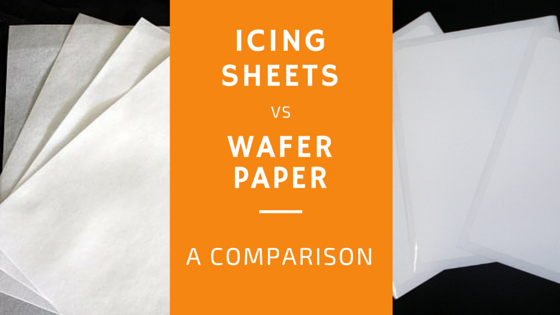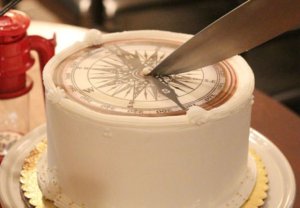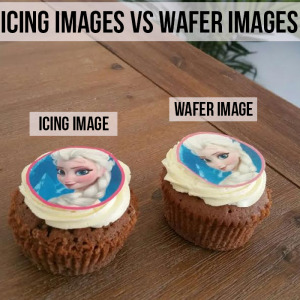When starting in Edible Ink printing one of the first decisions is choosing the paper you will use. Wafer paper or Icing sheets? Well, like many things – it depends!

So folks let’s break it down. We’ve highlighted the key points of comparison for each product to help make your decision, and then will summarise the best type for the occasion. The comparisons are based on:
Icing Sheets vs Wafer Paper Comparison
- Material / Texture – how does it feel?
- Printed appearance – how does it look?
- Application – how is it to apply and cut?
- Taste – how does it taste?
- Price – how much is it?
Material / Texture
Wafer paper (also known as rice paper) is a starch based material, made from potato or rice starches. It is a stiff but slightly transparent material, with some of the thicker sheets measuring up to 0.6mm in thickness. This means it generally maintains its shape unless exposed to a large amount of liquid, when it starts to dissolve. Common ingredients are dehydrated potato starch, oil, and water.
Icing sheets (also known as frosting sheets or sugar sheets) are layers of icing which are pressed thinly onto backing sheets. They are quite a flexible material, and much less transparent, but can be a little fragile when peeling. Ingredients are generally derived from tapioca or cornstarch, with added sugar and gums.
Material / Texture Winner: Icing sheets. The more flexible nature of the icing wins for edible printing, since it is specifically designed for this purpose. That said, wafer paper usually doesn’t have issues feeding through the printer.
Printed appearance
Wafer paper: Because it is slightly transparent and dissolves under liquid, the colour on wafer paper lacks a little vibrancy and images can come across a little blurred. For broader printed shapes, where the sheet isn’t the centerpiece of the design (eg leaves, butterflies and some patterns), it can work well.
Icing sheets: Since these sheets are specifically designed for printing on, images are generally clear and crisp. Colours are never completely true to the image (we are printing using edible inks after all!), but there are some fixes to get the colours close.
Printed appearance winner: Icing Sheets. These win hands down, with a crisp, clear image. Have a look at this example from Edible Cake Toppers (AU). From a distance, they look similar, although on closer inspection the clarity and colours of the icing sheet are much more defined.
Applying to cakes and cookies
Wafer paper applies easily, since there is no backing, however can tend to curl up on wet icing. Wafer paper doesn’t meld into the icing, meaning it can be tricky to cut through if placing as a centerpiece for a cake.
Icing Sheets are on a backing sheet, making peeling difficult, particularly in humid conditions, where it can sometimes ‘stick’ to the sheet. However this means that the icing is easily absorbed into the cake or cookie it sits on, so it cuts easily with a knife.
Application Winner: Icing Sheets – Although they can sometimes be troublesome to remove from the backing, icing sheets are significantly better at absorbing into the material it is being placed on for cutting.

Taste
Wafer paper generally has a flavourless taste (although some have a vanilla flavouring), and dissolve in the mouth, meaning it doesn’t affect the flavour of the food it is applied to.
Icing Sheets tend to have a slightly sweet and vanilla flavour (although taste can vary by manufacturer). Because the icing is generally absorbed into the baked goods, any taste is not usually noticeable.
Taste Winner: Wafer paper (just). This one’s a bit subjective – but you could argue wafer paper does have a slight advantage in that it is generally flavourless. But it comes down to what it is being applied to.
Price
Wafer Paper: around $10 / £6 for a pack of 25 of 6mm thickness. That’s around $0.40 / £0.25 per sheet.
Icing Sheets: roughly $28 / £22 for a pack of 24. That’s about $1.20 /£0.90 per sheet.
Price Winner: Wafer Paper – Wafer paper wins here, it is considerably cheaper. However Icing sheets do have ‘pre-cut’ options in circles and strips, which gives an extra edge on speed when applying to lots of cookies or cupcakes.
So which wins?
So all in all, icing sheets do have a clear edge over wafer paper for edible ink printing.
However- it really comes down to the purpose you are using for. If you are wanting images or logos to be the focal point of your design, or are re-selling them, use icing sheets. If you are just wanting to use as part of a decoration, for instance for butterflies, flowers and leaves, use wafer paper.
Which do you prefer? We’d love to hear from you in the comments below.
Other resources / sources: I want to thank Julia Usher for her in-depth guide around this topic on her YouTube channel and also on her forum at Cookie Connection.


Excellent post! And thanks for the shout-out!
No problem @juliamusher:disqus glad you liked it!
Nice post. This is what I was looking for since it is my first time in edible imaging. Thanks for that.
No problem @duketoniiduketon:disqus glad it helped you!
Photofrost makes an edible fabric sheets that eliminates most of the icing sheet problems
Thanks Cia.
Is there a post where someone has run into bleeding issues? I have run every type of test and when the sheet prints there is bleeding on some of the sheets. Or the image looks great, then you apply it to the cookie. I let them dry for over 12 hours and then package. Then once packaged, the image is no longer crisp but starts to bleed.
Hi Melissa, if you ever see blurring or bleeding on the printouts, this is usually due to moisture absorbed in the icing (eg through humidity).
One way to reduce this moisture is to dry out the sheets before and after printing (eg by placing in a fan oven, or placing on a heating plate). This in turn will help to keep the image crisp. Additionally, once dry, place within a zip-lock bag away from direct sunlight to help to preserve conditions.
Let me know how you get on, and if this helps to solve your issue.
I want to put a white wafer cutout on colored buttercream. Will it absorb the color or stay white?
Hi Deborah :) I know that this is a late response, but this is an old post :D I use it on colored fondant and have had no bleed through.